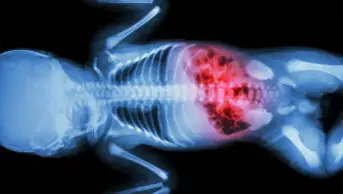This content was published in 2012. We do not recommend that you take any clinical decisions based on this information without first ensuring you have checked the latest guidance.
Introduction
Neonatology is the bridge between obstetric and paediatric medicine but represents only a small part of a continuum in terms of pharmacological effect: medicines that are used by a mother during pregnancy, and even before conception, may have an influence on the health of an individual from fetus to old age, and the inherited health of subsequent generations (by epigenetic mechanisms).
The clinical pharmacist will encounter three ‘groups’ of infants on the neonatal unit: those born before their due date; those who have a developmental problem (be it reduced growth in utero or a definable malformation); and those born around the time they were expected, but who are unwell. These three ‘groups’ are not discrete and often overlap. In this article we outline the path of normal pregnancy and the role of the placenta, as well as causes and prevention of preterm birth and some of the perinatal interventions used to reduce mortality.
Growth and environment: usual pregnancy
The length (or gestation) of a normal pregnancy is approximately 40 weeks from the first day of the last menstrual period (LMP). ‘Due’ dates are only an estimation as term birth may occur between 37 and 42 weeks.
The 40 weeks can be divided into 3 trimesters. During the first 12 weeks (first trimester) the embryonic brain, spinal cord, heart and other major organs begin to form. By the end of the first trimester the embryo’s face, toes, neck and genitals will have started to develop. During weeks 13–28 (second trimester) the risk of miscarriage drops drastically and the fetal organs start functioning (for example the fetus will produce insulin). From week 29 until birth (third trimester) the fetus will grow rapidly and mature towards readiness for birth (1).
The placenta starts to form during the fourth week of pregnancy, and continues to grow throughout the course of pregnancy. Functionally, the placenta is a lipid barrier connecting the developing embryo to the uterine wall to allow nutrient uptake, waste elimination, and gas exchange via the mother’s blood supply. With the exception of drugs with a high molecular weight (e.g. insulin or heparin) all drugs will cross the placenta by passive diffusion. Lipid-soluble, non-ionised drugs of low molecular weight will cross more rapidly than polar drugs (2,3). Drugs which, when given to the pregnant mother, will cause or contribute to the malformation or abnormal physiological function or mental development of the fetus or in the child after birth are classified as teratogens (2).
The effect of a drug on the developing fetus is dependant on the timing of exposure, dosage, maternal disease and genetic susceptibility. During the pre-embryonic phase (first 2 weeks of pregnancy), drugs will have an ‘all or nothing’ effect: damage to all or most of the cells results in death of the embryo. The fetus is most vulnerable to teratogens during organogenesis in the first trimester. Deficiency of folic acid during the first 12 weeks of pregnancy, when the spinal cord develops, increases the risk of neural tube defects such as spina bifida. Drugs taken after this time are more likely to cause damage to functional development within specific organ systems (2,3).
Preterm birth
Births that occur at less than 28 weeks are classified as extremely preterm; at 28–31 weeks as very preterm; and 32–36 weeks as moderate to late preterm.
Current clinical practice in the UK is that infants born at ≥25 weeks routinely proceed to neonatal intensive care, as most respond well to initial stabilisation in delivery suite. Population outcome measures for these infants are sufficiently compelling that this is standard practice (4). Data on outcome from UK infants born below this gestation (both survival and quality of life) do not suggest that an ‘at all costs’ approach is appropriate. An infant born between 23+0 and 24+6 weeks gestation will be assessed for condition at delivery and response to simple resuscitative measures; based on this a decision can be made about the appropriateness of offering intensive care (4). Earlier than this (<23 weeks) resuscitation is not usual as outcome is very poor: survival to discharge home is vanishingly rare and the vast majority have overwhelming disability (4).
Causes of preterm birth
Prematurity is the leading cause of perinatal death and disability (5). Preterm labour occurs in 5–13% of all pregnancies in developed countries (6,7,8). Preterm birth accounted for 7.6% of all live births in England and Wales in 2005 (5). There has been a reported increase in prevalence of preterm birth over recent years, with interventions such as assisted reproduction and the associated increase in multiple pregnancies contributing to this rise (5,6).
Preterm birth may follow: spontaneous labour with either intact membranes or after preterm premature rupture of the membranes (PPROM); induction of labour for maternal or fetal indications (e.g. pregnancy induced hypertension or intrauterine growth restriction) or caesarean section when it is unsafe to induce labour or allow labour to progress (7). PPROM complicates 2–4% of all singleton- and 7–20% of twin-pregnancies, and is associated with 18–20% of perinatal deaths (8).
About two thirds of preterm births are spontaneous (6). Causes may include; infection, inflammation, multiple gestation, placental abruption, hormonal disruptions (7,8) or may be unknown. Previous preterm birth increases the risk of subsequent premature delivery by 20–25% (9). Smoking, periodontal disease, low body mass index (<19kg/m2), and short cervical length also increase risk of preterm delivery. (7). Infection alone is associated with over 40% of preterm births (8).
Prevention of preterm birth
Prevention may be directed at all women before and during pregnancy (primary prevention) or directed at women who are already at a higher risk of preterm birth (secondary prevention) (6).
Primary prevention
Primary prevention includes weight optimisation, nutritional supplementation and smoking cessation programs. Nutritional and lifestyle adjustment are recommended to ensure that maternal weight is within the normal range in the pre-conception period. Low serum levels of micro nutrients such as iron and zinc are associated with preterm- and still-birth and are highly prevalent among pregnant women in low income settings (6).
Current UK (NICE antenatal care 2008) recommendations are that folic acid is taken pre-conceptually and in the first 12 weeks of pregnancy to prevent fetal neural tube defects (10). One cohort study in low-risk, singleton pregnancies found that folic acid supplementation for over 1 year pre-conception was associated with a decrease in the risk of preterm delivery, when compared to no supplementation (11). More studies are needed before long-term folic acid supplementation pre-conception could be recommended for reducing the risk of preterm birth. Evidence is also lacking in low risk populations to evaluate potential benefits of extended (non-folic acid) micronutrient supplementation.
Smoking cessation interventions have been shown to significantly reduce low birth weight and preterm births (12).
Secondary prevention
Secondary prevention focuses on women who are already at a higher risk of preterm birth, especially those who have a history of previous preterm birth. There are various interventions used. Notably, all secondary prevention (interventions to delay delivery) can have adverse effects if the fetus remains in an adverse intrauterine environment (6).
a) Cervical cerclage
Cervical cerclage can be offered to women at high risk of mid-trimester loss or spontaneous birth. A purse-string suture closes the cervical opening to prevent the gestational contents being delivered prematurely through failure of a weakened, shortened cervix. Improvements in screening (detecting cervical shortening on ultrasound) have enhanced targeting of this intervention, though much debate remains about optimal time to intervene. Where proven cervical weakness exists (witnessed by previous premature losses/deliveries) it has been suggested cerclage may help reduce preterm birth. It is notuseful in multiple pregnancies and may increase the rate of preterm delivery (13). Lack of both a clearly defined population which would consistently benefit from cerclage and consensus on timing of intervention mean that, in practice, the decision to place a cerclage rests with the senior obstetrician looking after the pregnancy (5).
b) Progesterone
Progesterone is responsible for establishing and maintaining a viable uterine environment during pregnancy. The administration of intramuscular and vaginal progesterone has been shown to reduce the incidence of preterm labour in specifically selected populations of high risk women. There is little evidence as yet for short-term or long-term benefit for the baby. The RCOG therefore recommend that, in women at high risk of preterm delivery, progesterone administration should be restricted to clinical trials to determine whether its use is associated with improved fetal, neonatal and/or infant outcome (14).
c) Antibiotic prophylaxis
Specific maternal bacterial infections have been shown to increase the risk of preterm birth including bacterial vaginosis (BV), which is characterised by an overgrowth of a variety of anaerobic organisms. There are conflicting data as to whether screening and treating women with BV decreases the rate of preterm birth. Few bacteria are easily cultured in the laboratory and newer, more sensitive methods (detecting bacterial DNA) are not widely available in the clinical setting. However, the number of positive detections of bacteria and other pathogens in amniotic fluid is inversely proportional to gestational age at delivery (15). This is significant as the population mortality of newborns is also inversely proportional to gestational age at delivery. Therefore, any antibiotic treatment during pregnancy is likely to be targeted at earlier gestations and the benefits have to outweigh the risks. (6)
d) Tocolytics
Tocolysis is the inhibition of uterine contractions with the aim of postponing preterm labour. A Cochrane library review compared tocolytics with no treatment or placebo (16). Atosiban and nifedipine appear to have comparable effectiveness in delaying delivery, with minimised maternal adverse effects or rare serious adverse events. Nifedipine is unlicensed for tocolysis but, unlike atosiban, it has the advantage of oral administration (17). There is little information about subsequent long-term growth and development of children born following use of either drug.
Tocolysis may be inappropriate if prolonging a pregnancy will be hazardous because of intrauterine infection or placental abruption. Use of tocolysis is only associated with a prolongation of pregnancy for ≤7 days and there is no evidence that they improve the outcome of the preterm birth or have any effect on morbidity (16). Clinically, however, those few days can be gainfully used to complete a course of corticosteroids or carry out an in utero transfer of the mother to a hospital with a neonatal intensive care unit (17).
Interventions to reduce perinatal complications at the time of birth
Antenatal corticosteroids
There is compelling evidence to suggest that antenatal corticosteroids are effective in reducing many of the complications of premature birth, especially respiratory distress syndrome (RDS) requiring formal respiratory support, intraventricular haemorrhage and neonatal death (18). There is also demonstrable reduction in incidence of necrotizing enterocolitis, need for respiratory support, admission to intensive care and systemic infection in the first 48 hours of life (vs. placebo or no treatment) (19). The Royal College of Obstetrics and Gynaecology (RCOG) recommend either two doses of betamethasone (12mg) given intramuscularly 24 hours apart or four doses of dexamethasone (6mg) given intramuscularly 12 hours apart (19).
Reduction of RDS is most significant when delivery occurs between one and seven days after the last dose of steroid (depending on regime). Beyond seven days after the last dose, the beneficial effects of antenatal steroids are not present. However, not enough evidence exists to be able to recommend repeated courses of corticosteroid as routine. Delivery within the first 24 hours after completing a course of antenatal steroids is also associated with a reduction in mortality. Most obstetric departments will begin a course of antenatal steroids in the hope of completing them prior to preterm delivery (19).
In the short term, antenatal steroid use is associated with a reduction in neonatal weight and head circumference. Potential longer term risks (effects on growth/neurodevelopment) or beneficial effects have not yet been elucidated (19).
Summary
The length of a normal pregnancy is between 37 and 42 weeks, babies born before this time are classified as preterm. Infants born at or after 25 weeks will be transferred for supportive care into neonatal units, and infants born between 23+0 and 24+6 may be supported based upon the decision of the senior clinicians. The causes of preterm birth include infection, inflammation, multiple gestation, placental abruption, hormonal disruptions and cervical incompetence. Preterm birth may be prevented or delayed through pharmacological and non-pharmacological management strategies, with varying evidence to support some of the techniques employed. Antenatal corticosteroids are given to reduce the complications of premature birth, with compelling evidence to support their use.
References
- E Norwitz & J Schorge. Obsetrics and gynaecology at a glance. Oxford: Blackwell science; 2001
- A Lee, S Inch & D Finnigan. Therapeutics in Pregnancy and Lactation. Radcliffe Publishing; 2000
- C Schaefer, P Peters & R Miller. Drugs during Pregnancy and Lactation. 2nd edition. Academic Press; 2007
- Wilkinson AR, Ahluwalia J, Cole A et al. Management of babies born extremely preterm at less than 26 weeks of gestation: a framework for clinical practice at the time of birth. Archives of Disease in Childhood Fetal and Neonatal Edition 2009; 94: 2–5
- Royal College of Obstetricians and Gynaecologists. Green top guideline No. 60: Cervical Cerclage. May 2011
- Flood K, Malone FD. Prevention of Preterm birth. Seminars in Fetal and Neonatal Medicine 2012; 17: 58-63
- Goldenberg RL, JF Culhane, JD Iams & R Romero. Epidemiology and causes of preterm birth. Lancet 2008; 371 (9606): 75–84
- Agrawal V, Hirsch E. Intrauterine infection and preterm labour. Seminars in Fetal & Neonatal Medicine 2012; 17: 12–19
- Petrini JR, Callaghan WM, Klebanoff M et al. Estimated Effect of 17 Alpha- Hydroxyprogesterone Caproate on Preterm Birth in the United States. Obstetrics and Gynaecology 2005; 105 (2): 267–272
- National Institute of Clinical Excellence. Antenatal care: routine care for the healthy pregnant woman. Clinical guidelines, CG 62. March 2008
- Bukowski r, Malone FD, Porter F et al. Preconceptual folate prevents preterm delivery. Am J Obstetrics and Gynaecology 2007; 197 (6s):3
- Lumley J, Oliver SS, Chamberlain C et al. Interventions for promoting smoking cessation during pregnancy. Cochrane database syst rev (online) 2004:(4). CD001055
- Berghella V, Odibo AO, To MS, Rust OA, Althuisius SM. Cerclage for short cervix on ultrasonography: meta-analysis of trials using individual patient-level data. Obstet Gynecol 2005;106:181–9.14
- The use of progesterone to prevent preterm delivery. Online statement from the Royal College of Obstricians and Gynaecologists. (Accessed 25 April 2012) (http://www.rcog.org.uk/womens-health/guidelines/use-progesterone-prevent-preterm-delivery)
- DiGiulio DB. Diversity of microbes in amniotic fluid. Seminars in Fetal and Neonatal Medicine. 2012 Feb;17(1):2–11
- Gyetvai K, Hannah ME, Hodnett ED, Ohlsson A. Tocolytics for preterm labor: a systematic review. Obstet Gynecol. 1999 Nov;94(5 Pt 2):869–77
- Royal College of Obstetricians and Gynaecologists. Green top guideline No 1b: Tocolysis for Women in preterm labour. 2011
- Roberts D, Dalziel SR. Antenatal corticosteroids for accelerating fetal lung maturation for women at risk of preterm birth. Cochrane Database Syst Rev 2006;(3):CD004454
- Royal College of Obstericians and Gynaecologists. Green top guidelines No 7: Antenatal Corticosteroids to Reduce Neonatal Morbidity and Mortality. 2010


